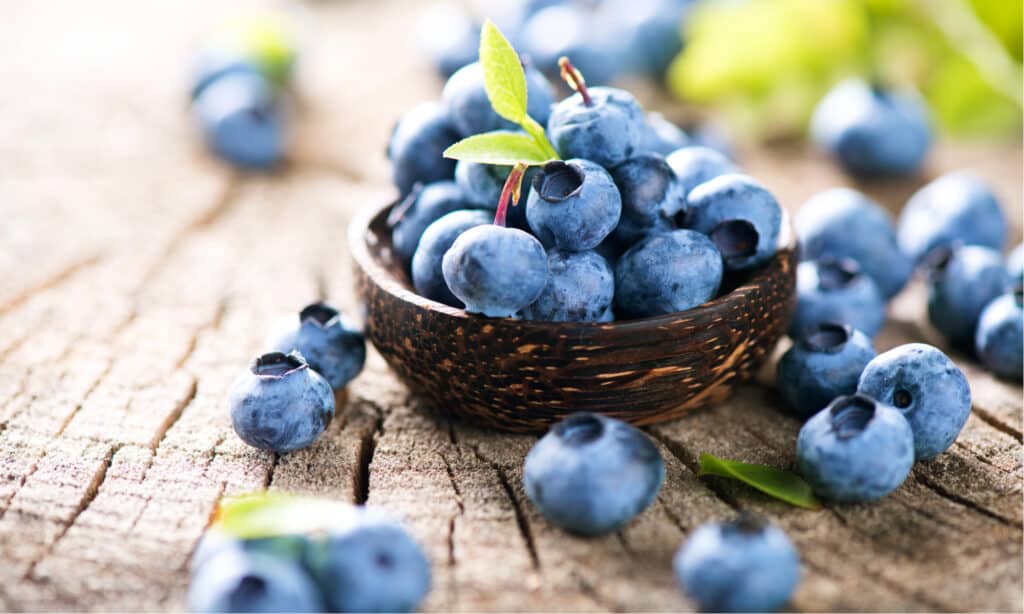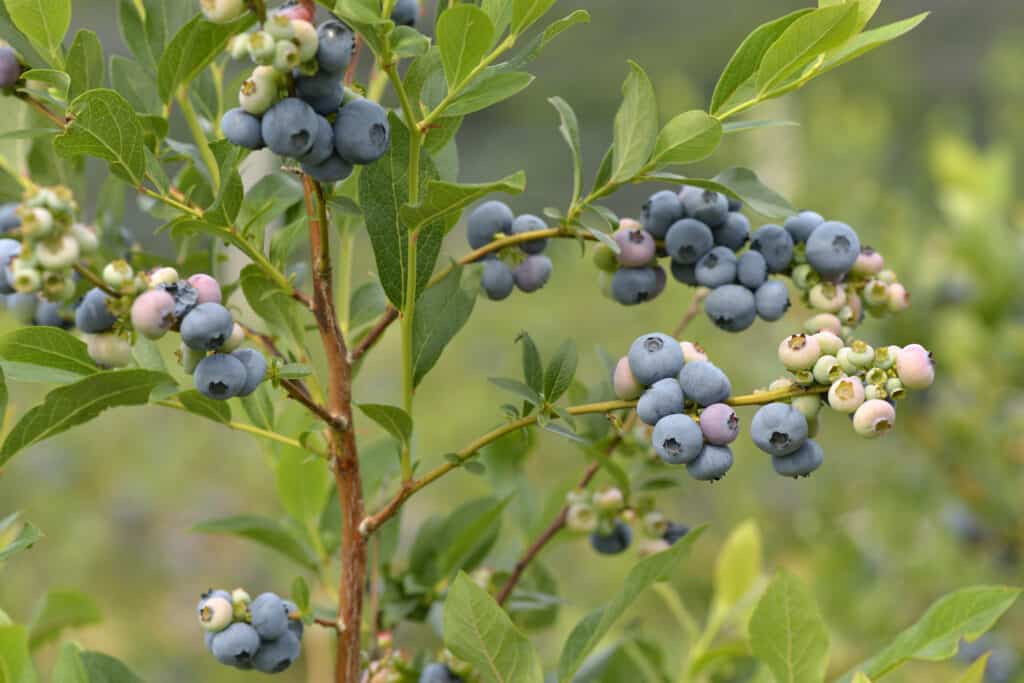Blueberries are a delicious and healthy fruit beloved by many for their tart flavor and ability to aid in heart, bone, skin, and blood pressure health. Blueberries not only produce tasty fruit but also give beauty to the environment they are planted in, which is why they are popular in landscaping. They can be grown in the majority of hardiness zones in the US and are virtually pest-free.
In this article, we’ll explore some interesting facts about blueberry plants and break down the basics of how to grow them at home with relative ease.
The Botanical Name and History of Blueberries
Blueberries are perennial plants that grow small blue-hued berries. Generally, there are quite a few species in the genus Vaccinium that are referred to as blueberries. However, the species Vaccinium corymbosum is the most common species of blueberry that is grown commercially or by home gardeners. As members of the Vaccinium genus, blueberries are closely related to a number of other edible berry plants such as cranberries, huckleberries, and bilberries.
The natural range of the genus Vaccinium is rather broad, with the majority of its species found in North America, Europe, and Asia. Several species that are commercially accessible, like the blueberry, are native to North America, namely the United States and Atlantic Canada for wild blueberries, and many US states and areas around British Columbia for cultivated highbush blueberries. For a millennia, First Nations peoples in Canada have eaten wild blueberries. By the turn of the 20th century, New Jersey became the first state to farm highbush blueberries.
In the Southern Hemisphere, countries like Australia, New Zealand, and some countries in South America produce species of blueberries from North America for economic purposes. The wild-harvested Colombian blueberry, also known as Vaccinium meridionale, is widely accessible in those areas.
Outside of the Vaccinium corymbosum species of blueberry, there are additional species and varieties out there that are popular among gardeners. Lowbush blueberries, or Vaccinium angustifolium, grow well in the coldest regions up to hardiness zone three. They develop in a very distinct way from other varieties, reaching a height of around one foot and spreading in a crawling manner. The berries, which are indigenous to the northeastern United States and southern Canada, have a waxy coating that gives the fruit a grayish appearance.
Half-high blueberries, which include species created by mating highbush and lowbush species, are a more recent breeding development. Most of them reach a height of up to four feet. Most of the Vaccinium virgatum, or rabbiteye blueberries, are farmed in the southeast of the United States. They are massive and can reach heights of up to 15 feet, and two or more plants are needed for the pollination of this species.

Blueberries (pictured) have been eaten and cultivated by people for hundreds of years, if not longer.
©Subbotina Anna/Shutterstock.com
Climate and Hardiness Zone Requirements for Blueberries
Blueberries can be grown in USDA hardiness zones three through nine, though many species from their genus can be grown in colder or hotter zones. Blueberries can only be produced in a limited number of humid, northern locations with low pH or acidic soils, moderate summers, and winter cold. For lower cold zones, extremely warm zones, and coastal zones, however, there are several new varieties available that can adapt to such climates.
When to Grow Blueberries
The ideal choice for choosing blueberry bushes is bare-root plants that are two to three years old. Older plants need a longer time to adapt to their new environment and experience more transplant shock. The best time to grow blueberry bushes is in the early to mid-spring. They are also capable of being planted in the late fall in USDA hardiness zones six and above.
Starting Blueberries From Seed vs. Buying Adult Plants
As we just mentioned, it might be better to buy an established blueberry plant over seeds. However, if you want to take on the challenge, give seed germination a try! It will take a lot of patience, as blueberries need to germinate and be grown in trays for about two years. However, the payoff is definitely worth it.
Blueberry seeds must first be placed in the freezer for around three months to simulate the winter chilling phase or “wintering” before being planted. By thawing the blueberries, then mashing, blending, or grinding them in a food processor, the seeds will settle to the bottom after being macerated. This makes it easy to harvest seeds from the fruit.
In warm areas, fall is the ideal time to plant seeds, but spring is ideal in cold climates. To start, sphagnum moss should be used to line a flat tray. After adding the seeds, cover the seeds with additional moss. Place the tray in a room that is between 60 and 70 degrees F, and then cover it with newspaper. Mist the moss thoroughly, then continue to mist as it dries each day.
After the seedlings appear, which should take approximately a month, you can take the newspaper off and leave the tray in bright indirect sunlight. The seedlings can then be placed in an equal mixture of peat moss, sand, and soil after they are two to three inches tall. Continue to mist them to keep them from drying out. In the spring of their second year, once the risk of frost has gone, they should be big enough to plant in your garden.
How to Grow Blueberries
Choose a place that receives full sun but is properly shielded from severe gusts of wind. Avoid placing your plants near large trees or bushes that might shade the area or compete with the plants for nutrients and moisture. Ensure that the planting area has effective soil drainage. To keep the soil loose, acidic, and well-draining, add some peat moss to the planting hole. Blueberries can also be planted in large pots.
Blueberry bushes should be set in a row approximately four to five feet apart, and neighboring rows should be separated by about 10 feet. Spread the roots of bare-root plants into a hole, cover them with soil, and make sure the root ball is no deeper than a half inch below the soil surface. Blueberries grown in containers should be planted at the same depth as they were in the nursery pot they came in.
Blueberries are self-pollinating plants. Planting two or more bushes will yield the best results, while three are much more preferable. To guarantee cross-pollination occurs, make sure the varieties you select will bloom at the same time.

Blueberries (pictured) must be shielded from strong winds in order to grow properly.
©iStock.com/hbak
Soil and Fertilizer Requirements for Blueberries
The pH of the soil where blueberries must be grown must be between 4.0 and 5.0. Just as well, they thrive on soil that has a lot of organic materials. Blueberries will grow better on raised beds where you can regulate the soil’s pH and composition if your garden has a lot of thick clay soil. Sandy soil is preferred over thick clay.
After planting, add a layer of mulch; wood chips, sawdust, or pine needles will help keep up the acidity of the soil. It is best to modify the soil the season before you want to plant in order to get the ideal soil pH for producing blueberries. To reduce the pH as needed, add garden sulfur to the top six inches of soil. You can also get your soil tested at your neighborhood garden center to find out how much sulfur you’ll need. To ensure you’ve created a great base for your blueberries, it is advisable to retest your soil before you start planting. Because the pH of the soil often returns to its previous level, you will likely have to continue amending your soil each year.
In the first year of blueberry growth, avoid fertilizing them. Before the plants are established, the roots are salt-sensitive. Once your blueberries have been growing for a year, there are two key times when you can start feeding them: when the flower buds first open and again when the berries begin to develop. Regular weed removal will help to prevent your blueberry bushes from losing out on soil nutrients to other plants.
Water Requirements for Blueberries
Be sure to deep water your blueberry plants at least once a week. Because of their weak roots, blueberries require at least a couple of inches of water each week and even more during dry spells. You can also use an automated watering system to supply your plants with constant water with little human intervention.
Temperature and Humidity Requirements for Blueberries
Depending on the species, different blueberry plants have different temperature needs. Highbush varieties designed for southern gardens can withstand freezing conditions, although the classic highbush varieties enjoy humid air and a cold winter environment. In general, between 60 and 70 degrees is ideal.
Sunlight Requirements for Blueberries
For optimum growth and fruiting, blueberry bushes require full sunlight. This implies that on most days your blueberry plant will get between six and eight hours of direct sunshine.
How Long Do Blueberries Take to be Ready for Harvest?
A mature blueberry bush takes around 10 years to reach maturity, but this also implies that they have a very long lifespan. It will take two or possibly three years before you begin to see any berry yields, but the wait will be well worth it. This is the type of plant you need to be patient for!
In general, blueberries are ripe for harvest between June and August. During their third year, most blueberry bushes begin to produce fruit, but they won’t yield fully until roughly their sixth year. Around eight quarts of berries can be produced by a single blueberry plant. By growing two or more bushes, such as early-season, mid-season, and late-season varieties, you can lengthen your blueberry crop significantly.
Blueberries must be tasted in order to determine when they are ready to be picked. Blueberries that are ripe will easily detach from the stem. After the berries turn blue, leave them on the plant for about a week, as this will result in a sweeter fruit.
Blueberry Companion Plants
The best blueberry companion plants flourish in acidic soil and draw pollinators like bees. We advise placing your blueberry bushes in a garden that also has strawberry, fern, holly, hydrangea, and lilac plants.
If you can give your blueberries enough attention and the right ongoing maintenance, you’ll be able to enjoy fresh fruits for quite a long time. It all comes down to having patience. With the research from this guide in hand, blueberries really are fun and easy to grow!
The photo featured at the top of this post is © Bukhta Yurii/Shutterstock.com
FAQs (Frequently Asked Questions)
Are blueberries easy to grow?
Blueberries are great for beginner gardeners because they do not need a lot of space or attention to flourish.
Is there a good way to grow blueberries?
Plant your seeds in full sun or partial shade. Avoid areas where there are a lot of trees.
How long do blueberries take to grow?
Blueberries will take around two years for this species to start producing fruit.
Thank you for reading! Have some feedback for us? Contact the AZ Animals editorial team.






